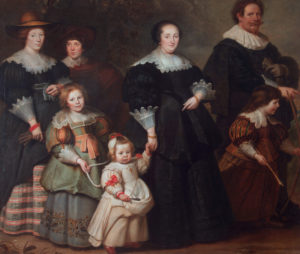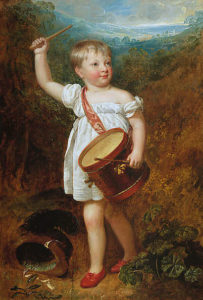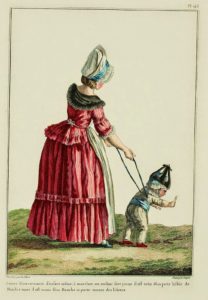
When looking at old photos and portraits of families with very young children, one almost immediately notices that the boys and girls are dressed alike–in dresses. This custom existed well before the Regency Era, and possibly for hundreds of years prior. Throughout history in Europe and America, all children of both sexes wore dresses and petticoats which were simply considered children’s clothing and not gender-specific attire. Dresses were easier than pantaloons or breeches when a caregiver needed to change the child’s diapers or nappies.
Another reason all children wore dresses is because a potty-training child didn’t have to worry about buttons or other fasteners which can be a difficult task for little fingers. Dresses were also easier to launder as there was less mess. And honestly, no one seemed to think anything about dressing boys and girls alike–that was simply how it was done. Some families put boys in plainer dresses as a way of announcing their gender, but many seemed to have dressed boys in the same frilly frocks as girls.
Once a child started walking, they were “short-coated.” This meant the child started wearing shorter dresses. Hemlines went from several inches below the feet which they wore as infants, to ankle or calf-length or even shorter, so the child could walk. At that time in England, all children still dressed pretty much alike. This practice of dressing boys and girls the same lasted until boys were “breeched.”

Getting breeched or “breeching” was the term for when a boy was dressed in breeches or pantaloons, or in later eras, in trousers. Boys were breeched anywhere from the time they were fully potty trained to the age of eight–or even older, in some cases. Between the ages of four and seven seemed to be most common.
Some boys were breeched all at once, with all their frocks replaced with breeches in one fell swoop, which must have created a flurry of sewing, unless the family were wealthy enough to purchase all new clothes for their son. Breeching was often a ceremonial event, including cutting a boy’s hair. However, some mothers then, as now, could not bear to cut off her son’s pretty curls. Some family traditions included a big celebration around the breeching ceremony, much like today’s birthday parties, which included visits and gifts from relatives.
The breeching rite of passage was a sign of a boy’s maturing, of his readiness to join more masculine pursuits. His mother and nursemaid seemed to have less influence on a boy after his breeching, and his father often got much more involved in overseeing his training and education. Many boys went away to school after the breeching ceremony, so it makes sense to me that some mothers might have been tempted to hold off breeching their sons as a way of keeping them close as long as possible.
Other boys seemed to have been breeched a little at a time, without ceremony, as breeches took the place of dresses gradually, perhaps as the mother could bear to admit her little darling was growing up, or perhaps as the family could afford to buy or make big boys’ clothes.
Occasionally, I find images of toddlers in breeches with leading strings. They were surely too young to have been potty trained because they seem to be relying upon the leading strings to keep them from falling, or at least from falling very hard. This particular image to the right is from a French publication, and since the French didn’t have all the same traditions as the English, it’s possible the difference is cultural by this time.
Sources:
The Breeching Ceremony of a Young Boy and His Rite of Passage: Regency Fashion
Boy to Man: The Breeching Ceremony
https://pediaview.com/openpedia/Breeching_(boys)


Many societies expected children to be potty trained by 18 months. When you don’t have modern diapers, it’s an issue.
A lot of “primitive” societies have it pretty well under control by 12 months.
Fascinating! I’ve never heard of breeching before. It would be great to mention it in more novels to increase the reality. For example, “He hadn’t been berated in such a way since his breeching.” I love your blog. Thank you!
I know that boys were breeched but what about girls? Was there some kind of thing that told that they were now in the schoolhouse as well? Or was it just a boy thing and girls weren’t given any kind of thing?
Thanks for visiting my blog, and thank you for the question. I haven’t run across anything special for girls. That their mother or nanny taught them the basics and then they usually got a governess when the parents felt it was appropriate anywhere between 10 and 16 years of age. There were schools for girls, but that was a new thing that hadn’t caught on during the Regency. For the most part, Regency families had their daughters taught privately at home. The next big milestone for a girl was when she was socially “out” and could attend balls, parties, and other social events reserved for adults. The age varied, but the range for being out seemed to be between 15 and 18. Does that help?